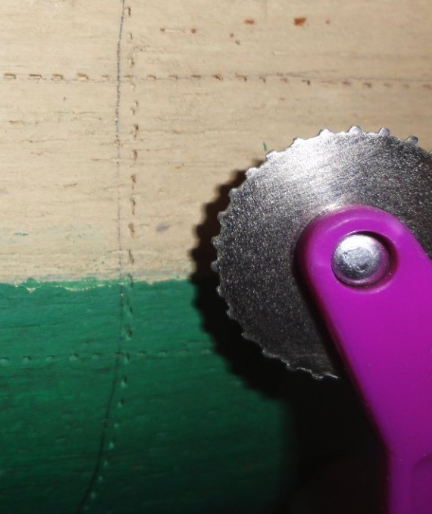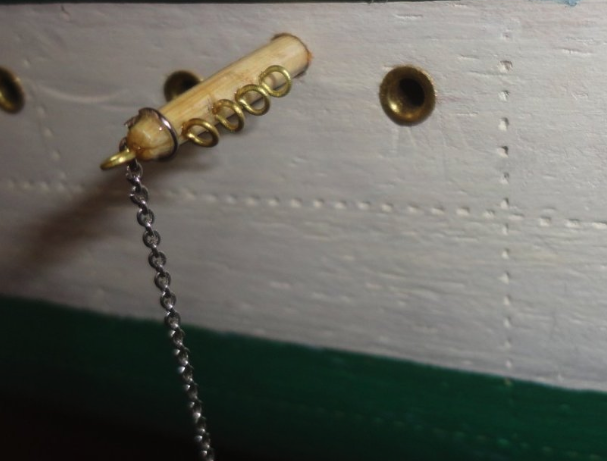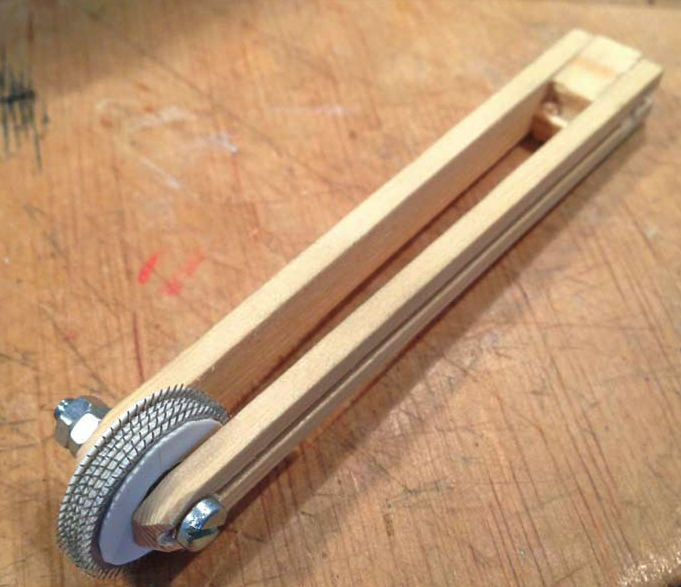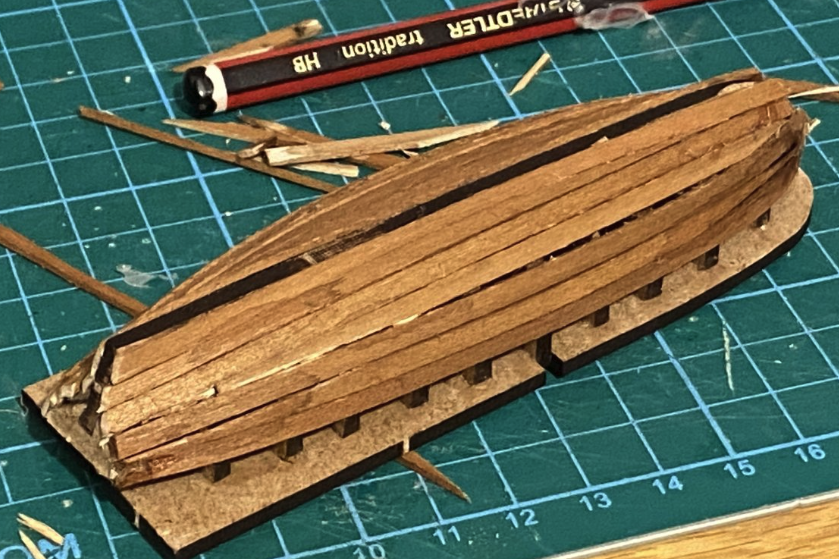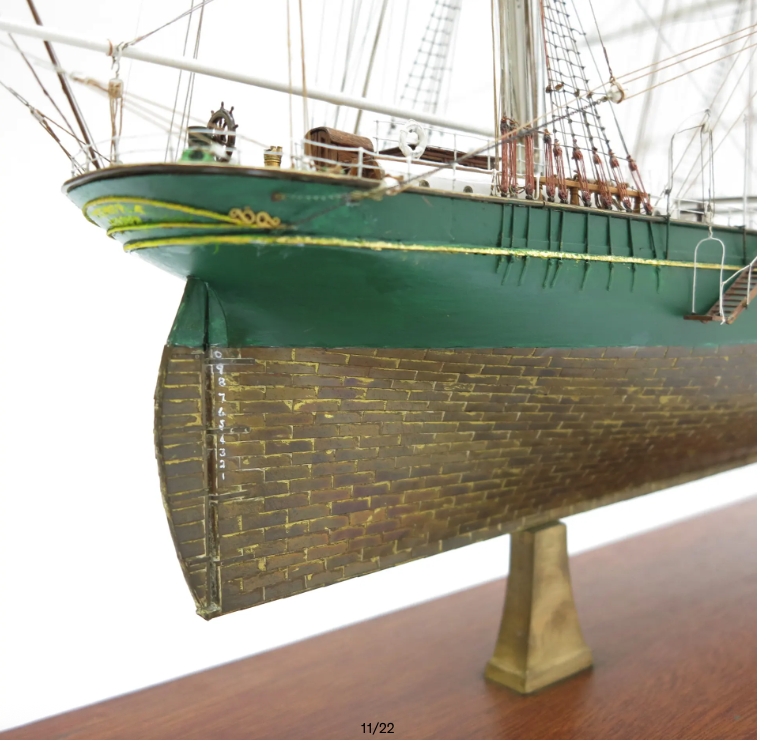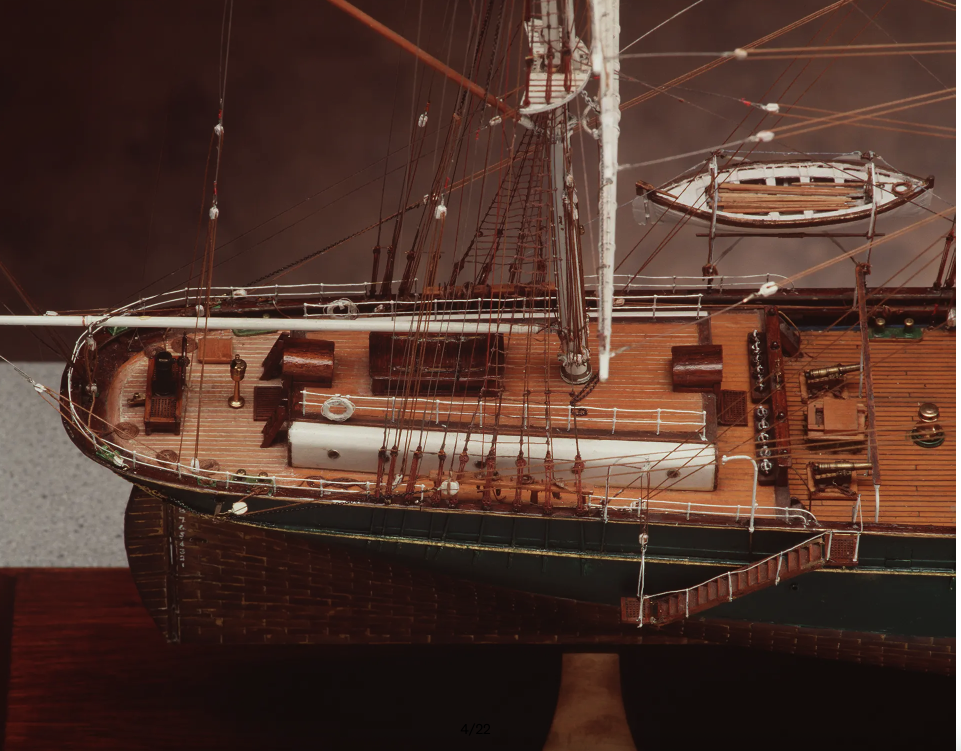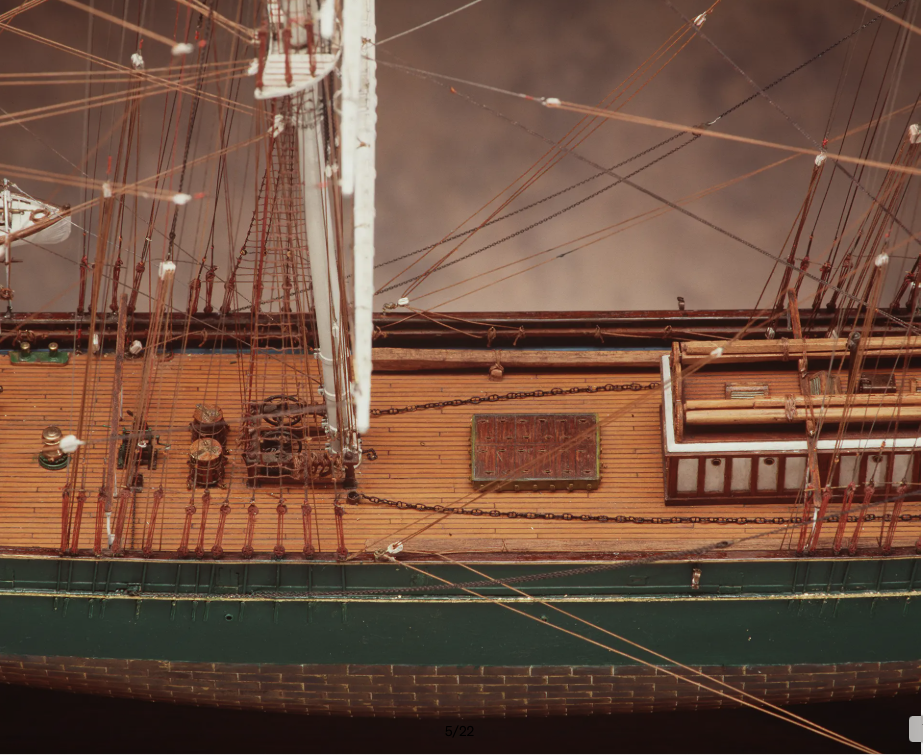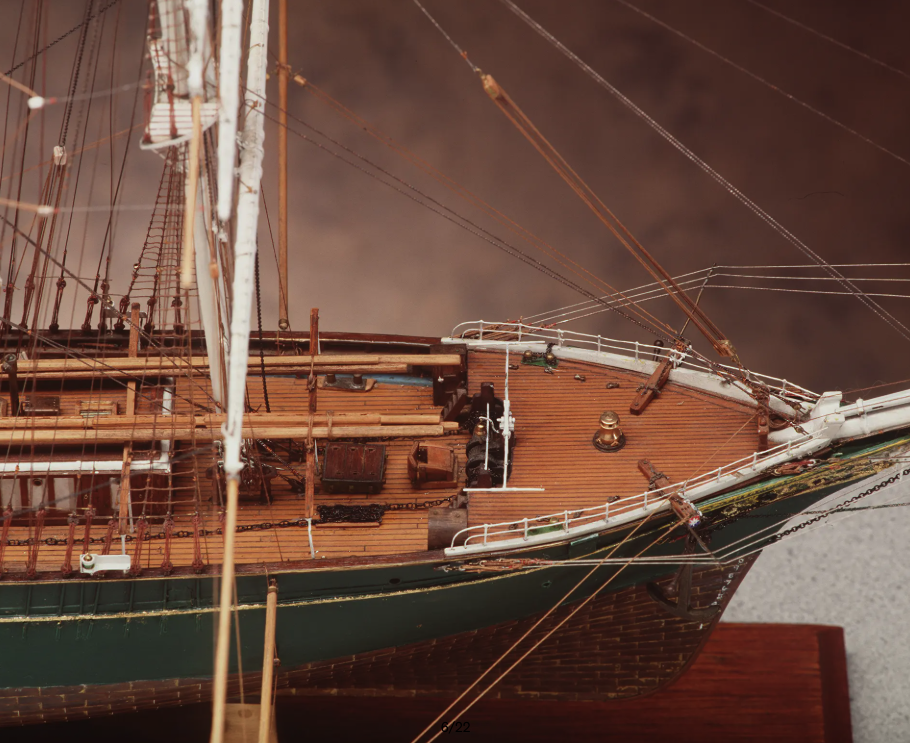-
Posts
1,453 -
Joined
-
Last visited
Content Type
Profiles
Forums
Gallery
Events
Everything posted by Snug Harbor Johnny
-
Per your previous post, I've had to do 'shop vac diving' a few times ... and most of the time could retrieve an item accidentally sucked into the vac - except for a couple of tiny items. I've also learned, before sweeping or vacuuming the floor, to get down on hand and knees with a flashlight to provide low-angle light to search for any little thing that may have dropped down since the last sweeping. I also have used paper printouts for scrollwork decorations. Screenshots of such details from an old photo can be adjusted in Photoshop for detail and sizing, printed out, then carefully cut out. (Thanks for the tip of cautiously using CA to strengthen the paper.) After application on a model, a compatible sealer coat will protect the applied decoration.
- 98 replies
-
- Cutty Sark
- Sergal
-
(and 1 more)
Tagged with:
-
Don't forget a time-tested alternative ... Linen. Now decent scale rope of linen is hard to come by (old time modelers use "Old Cuttyhunk" fly fishing line - out of production since the 1940s), but I suppose one could make their own with a Syren Rope Rocket or alternative rig ... yet fine linen thread has relatively limited availability and is expense, at that. Fine linen fabric ('lawn') is also hard to find, but the 70+ year old sails on a restoration I've worked on are still in good enough shape to re-use. Linen can last for many hundreds of years (e.g. Shroud of Turin) and there are samples of 2,000 year old Egyptian linen cloth.
-
Ahh the Tennessee build ... THATS where I remember the 'sewing' method for ratlines from. There are so many helpful tips and techniques on MSW, I should have started a notebook to record the log and post each good idea came from ... too late now, but I remember many of them.
A beginner may have to go through a number of build logs to absorb these techniques, which is daunting to some, but I thought it part of MSW's allure.
-
The divots on the copper bottom look great. As for the proposed clove hitches, at 1:144 scale, an easier way would be to 'sew' each ratline through the shrouds (with a paper guide in the back to keep the line straight) with a fine needle. Then tie just the end points with a cow hitch. The trimmed end of the line (after a tiny bit of glue to secure the hitch) will face inward - which looks better than the little 'tails' sticking outward from the end shrouds that one often sees on models.
- 27 replies
-
- Steam Cutter
- Harriet Lane
-
(and 1 more)
Tagged with:
-
I rolled divots with a modified (hand filed) pattern wheel to represent steel hull plates on a project (over existing paint), and they looked OK after a re-painting. Someone on MSW recently used wheels from a dermal roller to make tiny divots in a copper bottomed model. I suspect that a combination of light ruled horizontal scribe lines (with vertical divisions), followed by the dermal roller done over the base coat, would 'telegraph' through the final coat enough to resemble laboriously applied copper plates ... with random tacks in the the plates themselves.
- 27 replies
-
- Steam Cutter
- Harriet Lane
-
(and 1 more)
Tagged with:
-
I suppose it depends on which wall location one is looking at, and also the height of the interior space. E.g., a cabin wall that is the hull of the ship would logically be planked horizontally due to the many hull frames and curvature. A simple interior partition with a fore-and-aft orientation might comprise a 'header' nailed to the overhead beams and one on the deck, with vertical planking between them. But if framing is done (similar to a wall in a home), then horizontal 'ship lap' would be most common.
-
When you can can get a good buy on an older kit, that's one way to beat inflation. I queried for the scale of all Model Shipways versions of the Harriet Lane and wondered which one you got. A search result is pasted below: Model Shipways has offered the Harriet Lane in multiple scales, but the current main kit is 1:96 scale, a larger plank-on-bulkhead version, while older solid hull kits were available in 1:120, 1:128, and 1:144 scales. Key Scales & Kits: 1:96 (Current): A plank-on-bulkhead kit with laser-cut parts and detailed fittings, designed by David Antscherl and available from Model Shipways. 1:128 (Older): A solid hull kit with machine-carved hull, often found on resale sites. 1:144 (Older): Another solid hull version mentioned in forums. 1:120 (Very Old): An even earlier version of the solid hull kit. When buying, always check the product description for the specific scale, as Model Shipways offers versions from different eras.
- 27 replies
-
- Steam Cutter
- Harriet Lane
-
(and 1 more)
Tagged with:
-
We'll look forward to seeing those projects, mate !
-
The journey of a hundred miles begins with a single step. Fair sailing, mate!
-

Good 'Hobby Quality' Metal Lathes
Snug Harbor Johnny replied to tmj's topic in Modeling tools and Workshop Equipment
Per the above posts (I have the Unimat SL - compact but adequate for what I've done) - the back pulley on the Unimat 3 should be flipped so the largest wheel is on the outside. That way, the small wheel on the output pulley will line up with the large back wheel for a better speed reduction that is further reduced by a second belt going from the inner small wheel of the back pulley set to the larger pulley on the spindle pulley set. The motor does make noise, but has been in occasional use for decades. I'll look for any lubrication point. The unit is metric, so 1mm is about 39.5 thousandths. You have to figure that a cut will take twice that off the diameter, and be careful to 'creep up' to the size you want (measured frequently) - hence light cuts, but efficiency is not a factor in one-off work. Yet once a setup is perfected (sometimes a jig or holding fixture is developed from scrap), multiple parts can be made with OK accuracy ... just not high-precision. -

Good 'Hobby Quality' Metal Lathes
Snug Harbor Johnny replied to tmj's topic in Modeling tools and Workshop Equipment
Since my Unimat was given to me free from my Dad (I don't think he ever used it) I've hung on to it for a variety of odd jobs: e.g. turning aluminum barrel extensions and parfocalization rings for 2" telescope eyepieces (about the limit for the little lathe, using a 4 jaw independent chuck and light cuts all around for the o.d. and i.d.); altering large caliber brass casings for an antique Spencer carbine (3 jaw universal chuck comes in handy); turning small diameter steel parts for antique gun locks. (The underpowered lathe can only handle small diameter/light cut work in mild steel ... seems the unit was intended for brass & aluminum.); turning and/or tapering masts and spars for ship modeling. I found some largish rubber o-rings to use as belts, and generally set the belts for the lowest speed. Some tooling can be found on line, like a milling table, tool bits, etc. I should look for a live center. -
Your nice second planking completely conceals any irregularities of the first layer. I had a good look at Chuck Passaro's 4 part planking video again (not that I've done any planking in a long time (I have a couple solid hulls going), and see the good effect of marking, tapering and side bending. It gives me the idea of using veneer to over-plank a solid hull to get real look of planking - even if the hull is painted ... the plank lines and some of the grain will telegraph through a thin paint layer. (ref. the 1st video https://www.youtube.com/watch?v=KCWooJ1o3cM ) I saw a posting of building a ship's boat in an HMS Beagle log, and Chuck's taper methods could easily apply to get a better result on those darn little built-up boats found in a number of current kit offerings. Now the laser cut ribs come a bit thick as supplied, but they could be duplicated in thinner stock or simply thinned by sanding (but not too thin lest they break easily ... OCcre does have the builder glue the ends of the extended ribs to a piece of wood to build on to support the unplanked skeleton.) You can see the glitches with the untapered planks in the photos below - later fixed with filling and sanding). Tapering for smaller sized hulls may be a bit finicky, but should still work much the same as on larger hulls.
- 19 replies
-
- Viking
- Artesania Latina
-
(and 1 more)
Tagged with:
-

"Wind of the ball" injuries.
Snug Harbor Johnny replied to uss frolick's topic in Nautical/Naval History
There seems to be disagreement on this topic. During the war with Mexico, Thomas Jackson (later 'Stonewall' Jackson) had a cannon ball pass between his legs (spread in a stance) as he was rallying his men. There were no effects. I suppose if the 'miss' is less than an inch by a high velocity shot, there might be effects ... but I don't think the Mythbusters would take this chis challenge on - even with a ballistic gel simulation. AI Overview No, a solid cannonball passing close to a body will not cause injury; a person is only at risk of injury if the cannonball makes direct contact. Shockwave: The shockwave from a single, non-exploding projectile like a cannonball or bullet is not powerful enough to injure a person. The "shockwave" of a near miss: The idea that a bullet or cannonball passing by can cause a shockwave injury is false. Historical reports of near misses causing death are likely due to misunderstandings. -
With the copper applied to hulls at about .039" thick (about a millimeter, but the range was 0.7 - 1.1mm), for a scale model that could be half a thousandth or less. Ordinary paper is around 5 thousandths, but I measured 'Pyxix paper' (a type of impact activated receipt roll, where the 'ink' is incorporated on one side of the substrate) at .002 thick. Tissue paper may be a little thinner but tears too easily. I'll experiment with a thin coat of shellac on wood, gluing rectangle of Pyxis paper to that with thinned water-soluble glue - then a top coat of shellac prior to painting (with or without trying to roll dimples).
-
The most obvious difference from the prototype on Sergal's model - easily seen from a distance - is that the planking at the stern angles nearly vertical. The original ship's stern angled outward ... see the image below. You haven't go that far yet with planking, and with an extension to the poop deck the stern angle could be added. The other external feature is that Thermopylae did not have protruding channel to mount the deadeyes for the shrouds on. The gunwales were wider than average, so the deadeyes were mounted on the outer part of the gunwale where it overhung the bulwark. This is another correction that can be made. The images of a Thermopylae model by Cyril Hulmes on display in the Powerhouse collection (they offer public images on line at https://collection.powerhouse.com.au/object/211834 - samples below) can provide clear insights, as the modeler interviewed surviving ship's crew members before proceeding. One I'm working on will not have the anchor chain go as far back on deck ... a possible feature at the beginning of the ship's life, nor will i include the pair of cannon - also something from the early days that was soon discarded. The ship had other modifications over the years, the most obvious was the conversion to barque rig for the Northwest timber transport that followed a stint in the Australian wool trade. 1:124 is a challenge for a clipper of her size (mine is 1:110), and I'm considering using brown Czech demi-round beads for blocks (2.2 & 3mm) and deadeyes (4mm) found at a bead show. They are flattened (non spherical) and have a matte finish.
-
The typeface of the queries looks to be the style used by computers 20 years ago. What computer and operating system is being used. We've had to buy newer computers along the way as things get more sophisticated in our increasingly technological world, as may commercial websites don't work well on old machines/operating systems ... or simply don't work al all. 'Used to be that a home computer was considered obsolete at 10 years old. Now its looking like 5 ! Our "new" Mac Mini with Sequoia OS 15 has been set NOT to automatically install operating systems (or updates) and also NOT even to download them ... these are two separate functions. Still, we're now bugged to install the new OS 26 ... still quite 'buggy' and subject to revisions already. We may still opt for stable revisions of OS 15, but are loathe to risk OS 26 ... until 'forced' to by the inevitable 'wheel of progress' designed to make you buy a new computer. Once upon a time, a person only needed one typewriter (kids don't know what those were) that would last them their entire life, and then be passed on to a son or daughter.
-
I'd likely sand the sub deck to have an even curve first (no angles then),and focus on having pretty good symmetry around the bulwarks. If the symmetry is a small amount off where a mast goes, it will be hard to notice there than if the symmetry is much off at the prow and stern areas. I'm attaching a photo of a bluenose model showing that there is a lot of stuff going on at the bases of the masts. Sometimes, you just have to go ahead as best as you can, and deal with the occasional irregularities (or curve balls) modeling in wood might present you.
-
If you're bonding the ports from the inside, that implies you still have access from above. Once the initial attachment has cured, you can use '5 minute epoxy' to blob around the perimeter of the port on the inside (at least around the sides and top) as the epoxy starts to 'stiffen up, but is still plenty sticky. This will form a reinforcing 'fillet' where the inside surfaces of each port meets the wood of the hull. Once cured, the ports will be in there good-and-solid ... and secure to drill as needed from the outside. While there is access from above, you can drill the small rope hole above the gun port ... the one that the line for the gunport lid goes through. (Check to get the right location that will allow the lid to open most of the way.) Then install a line in the hole while there is access to knot the end on the inside so it won't pull out - you'll need the line later to tie the gun port lid up. To keep the gun port lid line from falling down into the hull, you can either tie a knot on the outside, or put a dab of epoxy on the knotted end inside the hull. Gun port lids would have a metal ring (or eyebolt) on the outside to attach the raising line, and one on the inside to attach the line to close the port securely. On little port lids, these can be really fiddly to deal with. Instead, you can have a hole through the port lid to pass the line from the raising hole through, and the line can be knotted then to keep the port lid open at whatever angle you want. then the line can continue from there to go inside the gun port (where it can be glued any way convenient). That way, one line does 'double duty' to hold the port lid open, and appear to be the closing rope going into the port. There can be some variation into exactly what angle the pot lids assume ... unless they are as far up as they can go. Now I didn't think this far ahead when closing my Vasa hull up, so now I think I'll just glue the lids open against the side of the hull, with a closing rope going into the port. The scale is 1:100 and the port lids are small ... just about every little detail seems small to my bumble fingers.
-

My introduction on Model Ship World
Snug Harbor Johnny replied to ANDY GRAY's topic in New member Introductions
Welcome aboard, mate! Some have employed lighting on various builds ... so perhaps searching various ways (e.g. LED, lights, lighting ...) might steer you towards useful information. A recent Ship In Bottle of Blackbeard's Queen Annes Revenge (as seen in the Pirates of the Caribbean series of films) featured the forward pointing flame thrower - lit up dramatically by LEDs. -
Most of the Bluenose or Bluenose II builds feature different kit suppliers in different scales, some with enhancements (minor 'busts'), but among the several of A.L.'s 1:75 Bluenose II I've perused (the kit is ion my stash) - a decent finished build to look at before proceeding is: https://modelshipworld.com/topic/22622-bluenose-ii-by-penfold-finished-artesania-latina-175-second-build-for-a-newbie-so-any-advice-welcome/#comment-671768 Most builders of finished logs (in the minority) glue the walnut keel pieces after second planking is done (one builder in a finished log is careful with 1st planking and omits 2nd planking altogether ... once filled and painted, it looks OK but smooth). 2nd planking done over a properly adjusted/filled 1st planking should need no further filling, and some don't paint to show off the wood planking. Painting over 2nd planking will still 'telegraph' the planks and some of the grain, and adds a lot of character to the model. A GREAT book to obtain (and copies are available on line - I bought through Amazon) is: Bluenose II Saga of the Great Fishing Schooners by L.B. Jensen. Just about everything you might want to know about the subject ship is in there, and can aid in proper rigging with or without sails.
-
You've done very well with the project at a challenging scale (most of the Scientific clippers were about 1:125) ... well above average form some that I've seen. You don't need to glue in the masts, as the shrouds of the standing rigging will hold them in place. An oldie I've done some restoration on did not have the masts glued, and that was a blessing - as I could take them out to work on repainting and fixing hull details. An alternative to casing is to mount a wood shelf on a wall with an identical shelf above it as long as the model fits in the space between the shelves with a little room to spare. Then you can screw in hooks into the front and sides of the top shelf, from which acrylic sheets (with holes to fit over the hooks) are hung - with the bottom edge of each sheet cut to overlap the bottom shelf. They will keep out most of the dust, yet the model will still be accessible by lifting the front panel. Every few years, a few deft passes with simple compressed air ("dust off" for computer keyboards) will clear away what little dust might have infiltrated the wall mounting. You only need to do the 'standing' rigging' - and using the durable rigging line from Ropes of Scale is a smart move. I know you will always be pleased when viewing the finished display, and you'll have good memories of your father. That's all have left of my own Dad, aside from one small airplane model he made.
-

Deck coloring
Snug Harbor Johnny replied to sgrez's topic in Painting, finishing and weathering products and techniques
'Never heard of using mineral oil before shellac ... and I'd be wary of it (or any pre application) without first experimenting on trial pieces. When making furniture from dark woods - such as mahogany or black walnut - I have used light application of 50-50 turpentine/boiled linseed oil to enhance the color of the heartwood. A couple days were allowed for outgassing and polymerization before the first coat of shellac. Amber shellac was used on mahogany, (which has red tones already in the wood) but clear was used on the walnut. The application of any sort of oil might affect the glue bonds between the deck and applied items, whereas shellac or varnish should not. Experiment on trial pieces first. Try using a light clear shellac first, followed by an amber overcoat, and compare that with a test of just the amber. -

Deck coloring
Snug Harbor Johnny replied to sgrez's topic in Painting, finishing and weathering products and techniques
Your sanded deck looks just fine - I really like the look. Decks were in constant use and got maintenance, yet some builders darken them. Since you want to glue some items to the deck, I'd wait before applying any kind of sealer. Both shellac and varnish have been used in the past, and that can keep fine particulates from getting into the wood fibers - and make future cleaning much easier, especially if the model will not be in a case. The application can be with a small art brush and is sparing, so a single application will have a mostly matte surface. Over application or multiple coats will make the surface shiny, and you might not want that appearance. Even if gluing wood to wood, the modeler's bane is that spindly items in the future might just come 'unstuck', like a fife rail with rigging attached. Then fixing it is a pain. That is why pinning is a good idea where possible. I've attached a photo from a project where I made a fife rail where the vertical posts are toothpicks with shaped ends (found locally at a food store) - other builders have used 'fancy' toothpicks (hors d'oeuvres skewers) for railings. So I simply marked and drilled holes in the deck for the round posts to go into and glued them in. The rail is attached so firmly that only a force great enough to snap the wood will cause failure. (Dropping a model is never a good idea.) The original builder just penciled the plank lines on the deck, and used an amber varnish over. 50 years of dust and grime (when I rescued the Gorch Fock from way in back of an jumbled antique shop) from the neglected model came off with a little TLC, and appear OK now.
About us
Modelshipworld - Advancing Ship Modeling through Research
SSL Secured
Your security is important for us so this Website is SSL-Secured
NRG Mailing Address
Nautical Research Guild
237 South Lincoln Street
Westmont IL, 60559-1917
Model Ship World ® and the MSW logo are Registered Trademarks, and belong to the Nautical Research Guild (United States Patent and Trademark Office: No. 6,929,264 & No. 6,929,274, registered Dec. 20, 2022)
Helpful Links
About the NRG
If you enjoy building ship models that are historically accurate as well as beautiful, then The Nautical Research Guild (NRG) is just right for you.
The Guild is a non-profit educational organization whose mission is to “Advance Ship Modeling Through Research”. We provide support to our members in their efforts to raise the quality of their model ships.
The Nautical Research Guild has published our world-renowned quarterly magazine, The Nautical Research Journal, since 1955. The pages of the Journal are full of articles by accomplished ship modelers who show you how they create those exquisite details on their models, and by maritime historians who show you the correct details to build. The Journal is available in both print and digital editions. Go to the NRG web site (www.thenrg.org) to download a complimentary digital copy of the Journal. The NRG also publishes plan sets, books and compilations of back issues of the Journal and the former Ships in Scale and Model Ship Builder magazines.





